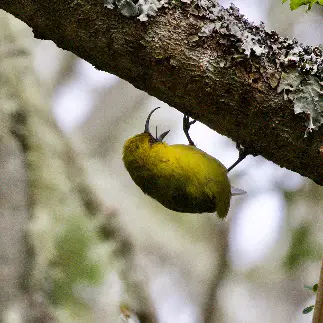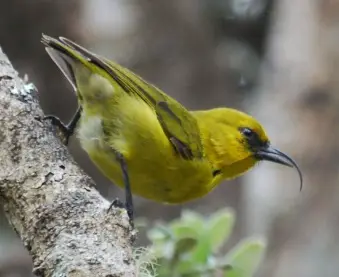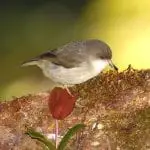Scientific Facts
| Common Name | ‘Akiapōlā‘au |
| Scientific Name | Hemignathus wilsoni |
| Lifespan | 13 Years |
| Size | 5.5 inches |
| Mass | 17 – 37 grams |
| Habitat | Dry and montane koa/‘ōhi‘a forest |
| Range | Endemic to Hawaii |
Information & Physical Appearance
Hemignathus wilsoni is a species of Hawaiian honeycreeper. The ʻakiapōlāʻau (commonly transcribed “akiapolaau,”) is endemic to the island of Hawaii. The native name is pronounced “ah-kee-ah-poh-lah-ow.”
This bird species is characterized by a stocky body, with the most famous physical trait being the specialized bill. The unique bill of the akiapolaau has a long, decurved upper mandible, while the lower mandible is significantly shorter and woodpecker-like.
The adult male akiapolaau weighs between 19.8 and up to 37 grams. The head and underparts are bright yellows in color. The wings and the back display hues of yellow-green, and there is a small-sized black mask.
The adult female akiapolaau is known to attain a body mass of between 17 and up to 37 grams. The females are characterized by underparts that display yellow to grayish-yellow tones and are olive above.
Adult male akiapolaau birds are not only larger than females, but they are also “equipped” with longer bills.
In both sexes, the legs are black, the bottom and the tail are white, and the wings are grayish-black.
Lifespan

Image Source
According to the World Life Expectancy Data Base, the akiapolaau’s lifespan is estimated at 13 years.
The generation length is 5.5 years.
Ecosystem & Habitat
The one-of-a-kind ʻakiapōlāʻau is known to mainly occur in old-growth wet and mesic forests in Hawaii, and in particular, in Hamakua and Kaʻū.
The dominant, vital plant species in this bird’s natural habitat include Metrosideros polymorpha (ʻōhiʻa lehua) and Acacia koa (koa) canopy species. Native forests with numerous koa trees are highly favored.
Because of the health and survival threats posed by non-native disease-carrying mosquitoes, the akiapolaau’s range has greatly decreased. Nowadays, this bird species can only be found at high elevations of between 4 300 and 6 900ft.
Back in time, the akiapolaau used to inhabit Mauna Kea’s Sophora chrysophylla (mamane), Coprosma montana (pilo), and Myoporum sandwicense (naio) dry forests, located at elevations of between 6 200 and up to 9 500ft. However, this former population was fully extirpated at the very beginning of the 21st century, more specifically, in 2002.
Food & Diet
The ‘Akiapōlā‘au feeds predominantly on insects. The most important prey items in this bird species’ diet include beetle larva, spiders, and insect larva.Although rarely, the akiapolaau is known to sometimes take nectar. It takes sap from ohia trees by excavating holes in the trees.
To locate prey, this species of Hawaiian honeycreeper is to tap the branches of koa, mamane, naio, and kolea trees, using its lower mandible. As soon as a prey item is located, the akiapolaau is to then again make perfect use of its lower mandible in a similar way; a woodpecker uses its bill as a chisel to open a hole.
Finally, the upper mandible is used for the purpose of successfully fishing out the desired prey item.
Feeding on the caterpillars and insects that live in koa trees’ wood and under the bark, the akiapolaau is equipped with one of the most unusual bills among all the species in the honeycreeper family.
Behavior

Image Source
Adult akialpolaau birds spend the majority of their time engaged in actively foraging. These birds are to creep along the branches and trunks of koa trees, digging or tapping with the lower bill while searching for wood borers.
These birds are also known to glean surface insects. Using either mandible, they are to dig into exposed holes, as well as branch ends, and are to strip bark.
Once a borer is found under the surface of the wood, these birds are to expose the prey by hammering with their lower bills. Ultimately, the upper mandible is then used to probe and to finally extract the borers from the trees’ cavities.
Reproduction

Image Source
The akiapolaau is to usually choose to nest in Metrosideros polymorpha trees (ohia lehua trees). Nesting takes place in dense foliage and branches.
Up-to-date, researches have managed to discover several nests of this bird species. In most of the nests, only a single egg was found, with the rate of the egg to maturation having been estimated at only 50%.Even though the akiapolaau breeds any time of the year, this species is known as a slow reproducer, as breeding typically occurs only every other year. The peak of the breeding season is most commonly from early February to late July.
The akiapolaau is monogamous. Once a pair is formed, the partners are to remain together for several seasons, forming populations that are estimated as stable. During the breeding season, the male defends a small territory.
Health Risks, Survival Threats & Conservation
Tragically, the akiapolaau may be the last species of its genus. The fears regarding the possible extinction of this incredible bird species are further fortified by the recent disappearance of the nukupu’us that once used to be abundant in Kauai and Maui before their disappearance in the 1990s.
The akiapolaau is the only member of the subgenus Heterorhynchus. The akiapolaau is unique among nukupu’us as it is known to feed exclusively by preying on insects, using its unusual woodpecker-like bill and occupying a woodpecker-like feeding habitat. In contrast, the nukupu’us were hummingbird-like nectarivores, as well as insect-eaters.
In the late 19th century, as well as in the early 20th century, Hemignathus wilsoni used to be common. The increase of wild stock was greatly adversely affected by non-native animal species introduced to the island, especially rats. Rats are to blame for destroying a huge amount of the akiapolaaus’ eggs.
Ultimately, the akiapolaau population broke down into a total of four populations. The smallest population consists of three birds. Another population consists of as few as twenty birds.
The third of these four small populations consists of forty-four birds. The largest population is known to contain approximately 1 097 birds.
It tends to be very hard to find the akiapolaau birds in the wild in order to successfully monitor and describe the number of these birds left. However, the number of akiapolaau birds in the wild has been estimated as continuously dropping.
The weakest of all the four populations is the smallest one, containing only three birds.
Currently, the threats to these amazing endemic bird species’ survival include loss of habitat, introduced non-native plant and animal species.
Habitat loss is related to forests being cut down for modern-day housing, recreation, farming, ranching, and grazing.
The introduced animal species that are harmful to the akiapolaaus’ populations include rats, which attach both the birds’ food sources, as well as the birds’ nests and the birds themselves.
Also, dogs and cats do hunt the akiapolaau, too. Furthermore, pigs have been found to create harmful wallows. These wallows can destroy the roots of trees that are vital to the survival of the akiapolaau, causing the trees to ultimately die, and hence, causing the akiapolaau to slowly die in return.
In addition to the direct harm on the akiapolaaus’ populations associated with the wallows created by pigs, there is yet another related threat.
These exact wallows can be further used as a breeding ground by disease-carrying mosquitoes. Disease-carrying mosquitoes were introduced to the islands, and are not native species. Therefore, the birds are not resistant to the deadly disease brought by these mosquitoes.
Introduced plants, aka alien plants, such as the strawberry guava, have been progressively upstaging koa and ohi’a trees, the two species of trees that the akiapolaau is most highly dependent on, and also sharing a deep ecological relationship with.
Due to its fragmented populations, progressive habitat loss, low reproductive numbers, and low numbers in general, the akiapolaau was officially included on the endangered species list back in 1967. Ever since some conservation efforts have been applied, however, the results are not even close to possibly indicating a brighter future for this extraordinary bird species.
To help save the akiapolaau, efforts were put into establishing a captive population. Also, aggressive reforestation took place. Additionally, actions have been undertaken for the purpose of removing feral ungulates.
Last but not least, researchers have been deeply engaged in the collecting of data needed to understand better the akiapolaau’s life, with a mind to helping the rest of the conservation plans to bring better results.
However, up-to-date, it remains quite difficult for conservationists to obtain the needed number of eggs of this species to create a healthy, captive breeding population. Plus, conservationists need to find more adult akiapolaau birds to be able to keep up with the populations that are still left in the wild.
According to the data listed on the IUCN Red List of Threatened Species, there are currently as few as 800 mature individuals in the wild. The population trend is decreasing. Although an active recovery plan is running, there is still a lack of a systematic monitoring scheme.
Availability – Where to Get an Akiapolaau
One can try to get closer to the akiapolaau by choosing to visit its natural habitat in Hawaii. However, do mind that taking a glimpse of this extraordinary bird species in the wild tends to be quite a rarity, and is progressively becoming harder and harder, especially with the ongoing shrink in populations.
The akiapolaau cannot be kept as a pet.
1. Pu‘u ‘Ō‘ō Trail
The Pu‘u ‘Ō‘ō Trail used to be a cattle driving trail. Back in time, the former cattle driving trail linked Puʻu ʻŌʻō Ranch located on Maunea Kea and Keauhou Ranch, located close to Kilauea.
Currently, Pu‘u ‘Ō‘ō Trail gives access to an easy round-trip hike. However, although easy, the hike is also a lengthy one, as the trail is 7.4 miles long.
Hiking this trail will lead bird watch enthusiasts and nature lovers alike across the rough ʻaʻā lava flows and the smooth pāhoehoe.
The trail meanders out and in of the older-growth forested pockets that were spared from lava flow (aka kīpuka). These forested pockets are filled with flocks of native honeycreepers thriving among ancient trees.
Apart from possibly getting a glimpse of the akiapolaau, the kipuka is a good place to look for other of the endangered Hawaiian birds, such as the ʻalawī.and the ‘akepa.
2. Kaulana Manu Nature Trail
The Kaulana Manu Nature Trail is about to become open for visitors as of January 2020. Formerly known as Kipuka 21, the Kaulana Manu is an interpretive trail described as “family-friendly.”
Similarly to the Pu‘u ‘Ō‘ō Trail, the Kaulana Manu Nature Trail consists of kipuka – older forested pockets that were spared from lava flows.
Kaulana Manu is an especially favorite spot for birders, as one can catch a glimpse of many of the native forest birds of Hawaii, including but not limited to the akiapolaau.
Interesting Facts
1. The akiapolaau’s song is described as a rapid-fire, quite loud warble.
2. The distinct, rich calls are most commonly human-like whistles consisting of between 1 and up to 4 notes.
3. When juvenile akiapolaaus are to beg for food, their beacon calls are a “tsewp” sounds that are loud descending.
4. Akiapolaau birds are also known for their whisper songs. These songs include frequent fragments of the akiapolaau song, in combination with imitations of various other species. Whisper songs can be especially extensive.
5. The male akiapolaau’s song is either a rapid “warba-warba,” or a short yet loud “pit-er-ieu.”
How to Care for the Akiapolaau
To take the best care for the akiapolaau, be a smart consumer. Avoid over-consumerism and always choose eco-friendly products and services over non-eco-friendly alternatives.
Also, take part in ecotourism practices. One can further spread awareness by advocating for preserving biodiversity while on vacation, or by merely sharing the story of the akiapolaau with other people by using the power of social media and/or via face-to-face contact. In addition to that, it is possible to support, volunteer, and/or visit various wildlife protection organizations and campaigns.
FAQ Section
What Does the Akiapolaau Bird Look like?
The akiapolaau is a small-sized Honeycreeper, reaching up to 5.5 inches in length. In males, the underparts and the head are bright yellows, while in females, the underparts are yellow to grayish-yellow.
Is the Akiapolaau Endangered?
Yes, the akiapolaau is officially listed as Endangered on the IUCN Red List of Threatened Species. Based on the 2016 global assessment, the population trend is decreasing, with a total of 4 highly fragmented populations still surviving, and less than 800 mature individuals.
Why is the Akiapolaau Endangered?
The akiapolaau is endangered with extinction because of habitat loss due to clearing of land for ranching and livestock farming, wood harvesting, and logging, as well as because of invasive, non-native species and diseases.
Is the Akiapolaau a Honeycreeper?
Yes, the akiapolaau is one of the Hawaiian honeycreepers. Honeycreepers are endemic to Hawaii, and the akiapolaau is considered one of the most unusual of all honeycreepers, because of its uniquely specialized woodpecker-bill and woodpecker-like feeding habitat.



